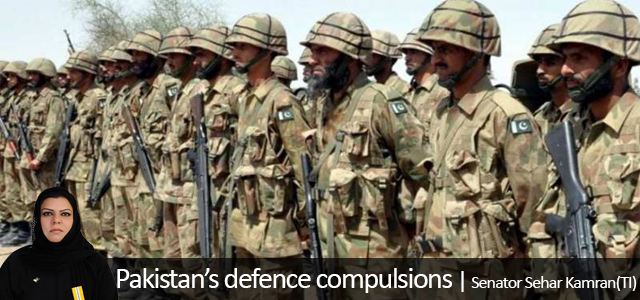 In the rapidly changing international environment, Pakistan’s defence planners are confronted with a number of fundamental issues that mainly emerge from some transitions at the national, regional and international level. The expected drawdown or total military withdrawal of American and NATO forces from Afghanistan and the new American strategy of ‘Asia Pivot’ clearly indicate that a relative shift in the balance of military power in Asia is undoubtedly underway.
In the rapidly changing international environment, Pakistan’s defence planners are confronted with a number of fundamental issues that mainly emerge from some transitions at the national, regional and international level. The expected drawdown or total military withdrawal of American and NATO forces from Afghanistan and the new American strategy of ‘Asia Pivot’ clearly indicate that a relative shift in the balance of military power in Asia is undoubtedly underway.
This shift amidst tensions and disputes in the region will result in hefty defence budgets and military developments and procurements at a much larger scale by the Asian States than was the case earlier. According to the International Institute for Strategic Studies’ military balance report of 2014, Asian defence spending in 2013 was 11.6 per cent higher than in 2010. In one way or the other, the game of power has begun in Asia; and Pakistan, because of many reasons, is not in a good position as far as defence and security are concerned. There is a three-layered problem, which becomes more complex, more unpredictable and more unanticipated, when the forces at these three layers interact which each other.
At the outer-layer, due to a relative shift in the balance of military power to Asia, the Asian countries are rapidly increasing their military capabilities, some of which are generally related to routine force modernization, and others for enhanced power projection, or deterrence. A chain reaction that starts from the accumulation of American military forces in the region and a circle of alliance around China to contain it under the so-called ‘Asia Pivot’ strategy fuels systematic military competition that drags India and Pakistan in. China’s defence spending rose 7.4 per cent in 2013 as compared to 2012, and India has been marked as the largest arms buyer state in the world.
This upward shoot in Indian defence developments and acquisitions are not aimed at security but the projection of Indian military influence in Asia. The development of an Inter-continental Ballistic Missile (ICBM) like Agni-V reflects the Indian hegemonic future designs. The BJP has won the Indian elections and in its election manifesto, stated a commitment to indigenise the development of defence technologies through encouraging domestic industry to have a larger share in design and production of military hardware for both domestic use and exports. According to some reports Narendra Modi is likely to spend an additional $200 billion on stealth fighters, main battle tanks, backfire bombers, aircraft carriers, frigates and Scorpion submarines.
Pakistan’s security dilemma runs along this uncontrollable systematic problem, where it has to balance between its socio-economic development and security. But a blurred and chaotic picture makes it difficult to strike a reasonable balance between both these continuums.
At the second, regional level, Pakistan is facing a three-front problem. On the east, India with its rapidly increasing military might, offensive military doctrines and new right-wing government. In the North West, an unreliable and presumably unstable Afghanistan because of a possible civil war after the NATO drawdown and along its western border, the deployment of Afghan National Army (ANA).
Finally at the third, national level; rising militancy, separatist violent movements and a conservative political right-wing, pose the single biggest challenge to Pakistan’s internal security and integrity. Pakistan has suffered the loss of more than 40,000 lives and economic losses of more than $100 billion.
To overcome these challenges, Pakistan needs to work at two levels. At the strategic level, it needs to take into account the changing strategic scenarios and their implications on Pakistan’s security, and then take appropriate measures to deal with them. Nuclear weapons play a vital and central role in this regard. Though the likelihood of a large-scale conventional war between India and Pakistan has become obsolete because of nuclear deterrence, Indian intent to fight a limited war under a nuclear threshold, development of second-strike capability and ballistic missile defence and bringing in military doctrines like Cold Start Doctrine (CSD) or Proactive Military Operations (PMOD) in South Asian strategic environment, have forced Pakistan to revisit its strategic and conventional development postures. Pakistan has responded with the development of short-range ballistic missiles such as NASR and cruise missiles such as Babur to fill the gaps at the tactical and operational levels. However, to strengthen the structure of strategic stability, Pakistan needs to develop its sea-based nuclear deterrence capability, along with multiple independently targetable re-entry vehicles (MIRVs).
At the conventional level, Pakistan needs to enhance its counter-insurgency capabilities, along with effective security of the western border along Afghanistan. To this end, adequate budgetary allocations are needed for training and procurement of equipment for conventional operations and fencing and building of more check posts along the Afghan border. In addition, the capacity and capability of intelligence agencies for accurate and timely detection of threats needs to be enhanced. Investing more on counter-insurgency training and early and accurate intelligence gathering will greatly reduce the fatality rate during future counter-insurgency operations. Also, the most important area to focus on beyond enhancing our kinetic capability is to increase our non-kinetic capabilities. Effective non-kinetic operations with limited and well-calculated kinetic operations will result in early and effective elimination of threats.
Pakistan’s defence procurements have remained constant in five years before 2013. However, after that, Pakistan increased its defence spending by 15 per cent, from $6.12 billion to $6.45 billion in 2013-14. Whereas, in India, there has been double digit growth in 2004-05 (17.92 per cent), 2008-09 (10 per cent), 2011-12 (11.59 per cent) and 2012-13 (17.63 per cent). Analysis of the statistic testifies the fact that India has regularly enhanced the defence budget substantially, whereas in the case of Pakistan, it has remained more or less constant. In fact it does not even cater for inflation. Pakistan’s defence allocations have been at the lowest as compared to the rising defence budgets of India, China and Turkey.
There has been a lot of criticism on the defence spending of Pakistan, but if we see Pakistan’s defence budget against its defence requirements in the backdrop of the threat that Pakistan faces, there is a huge disparity between threat and security. There are geo-political realities which can’t be ignored and it is important for Pakistan to ensure its security, safeguarding its territorial integrity and sovereignty. The budgetary allocations for defence have been kept lowest in the previous few years. However, the changed national, regional and global security environment does demand an increase in our defence budget; appropriate fiscal allocation is required to meet the country’s defence needs. In this regard, a thorough review and analysis is required to outline the defence budget for 2014-15. In this process, various defence and strategic institutions should be involved to fully grasp ground realities. In the same vein, the political leadership should also play its due role in strengthening the defence and security structure of the state by understanding geopolitical realities and realizing the responsibility that people have put on their shoulders.
The writer is the President of Centre for Pakistan and Gulf Studies and Member Senate Standing Committee on Defense, Foreign Affairs , Overseas Pakistanis and Human Resource Development and Functional Committee on Human Rights.
Source : The Nation


